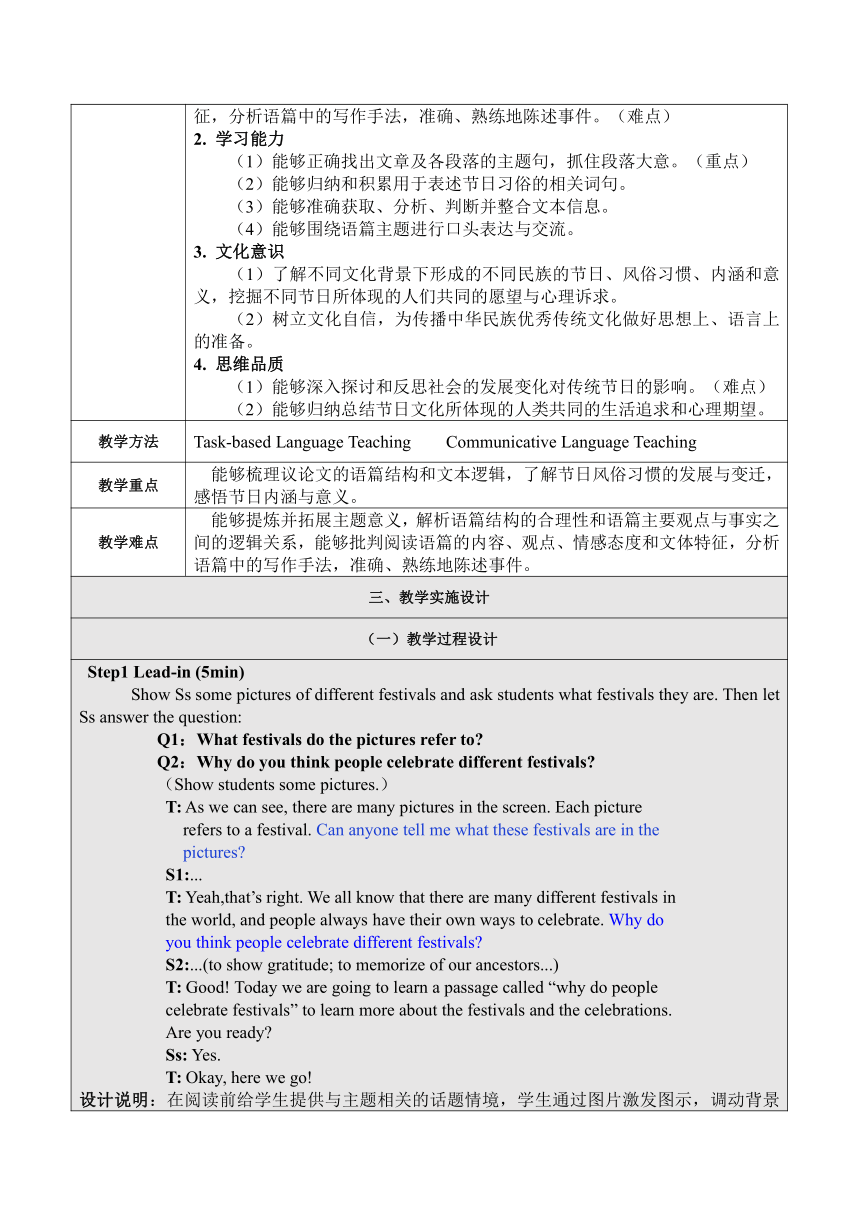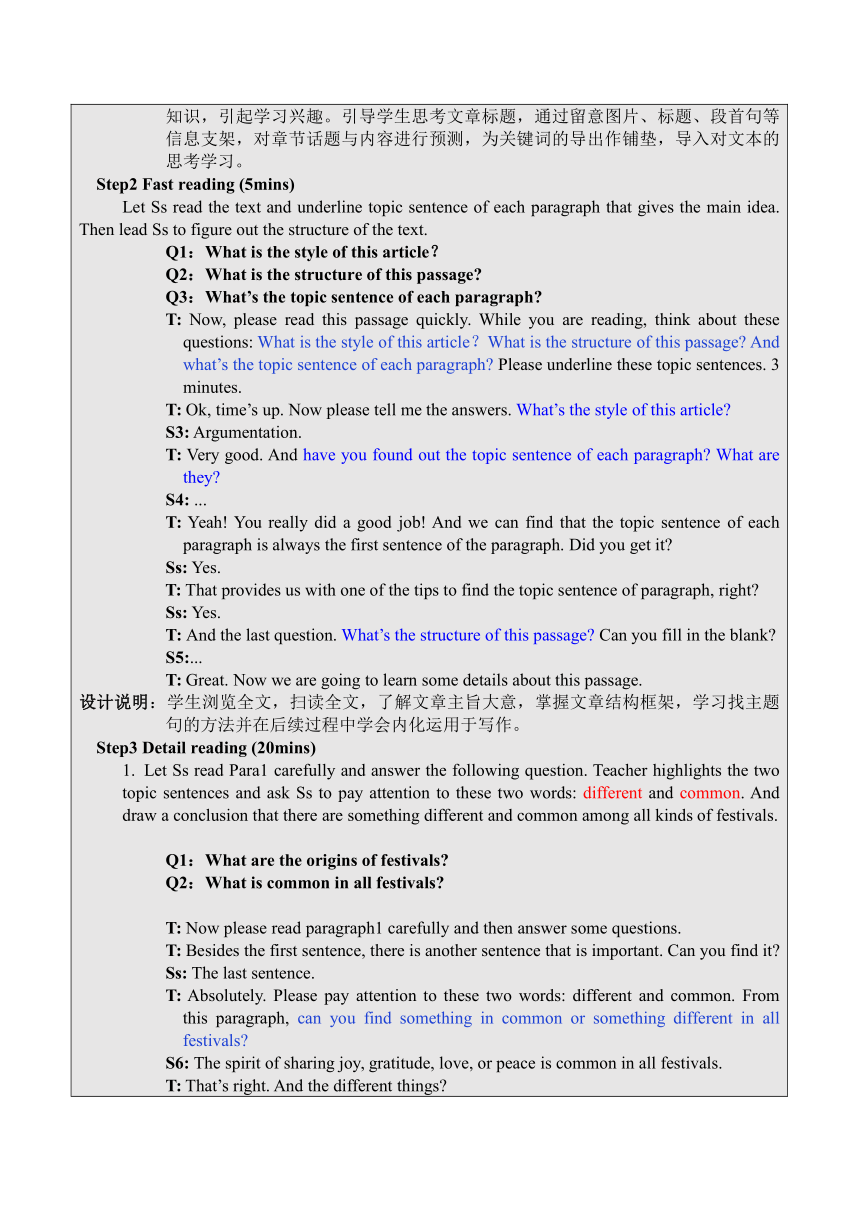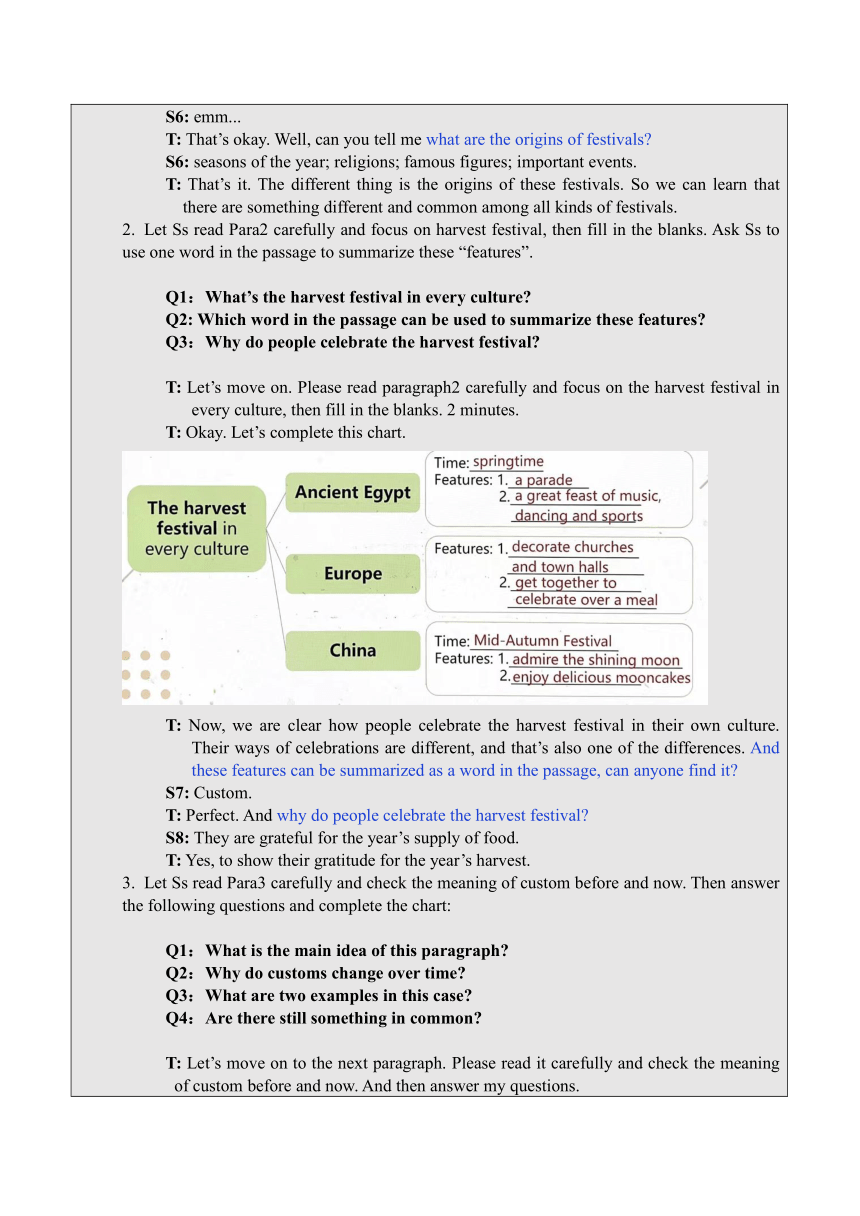人教版(2019)必修 第三册 Unit 1 Festivals and Celebrations Reading and Thinking 教学设计(表格式)
文档属性
| 名称 | 人教版(2019)必修 第三册 Unit 1 Festivals and Celebrations Reading and Thinking 教学设计(表格式) |  | |
| 格式 | doc | ||
| 文件大小 | 904.0KB | ||
| 资源类型 | 教案 | ||
| 版本资源 | 人教版(2019) | ||
| 科目 | 英语 | ||
| 更新时间 | 2024-09-21 12:20:27 | ||
图片预览




文档简介
教学设计
一、教学基本信息
课题名称 Unit1 Festival and Celebrations Reading and Thinking 课型 阅读课
学生年级 高一 授课时间 40mins
二、教学分析设计
语篇研读 【What】本课语篇选自人教版高中英语必修三Unit1 Festival and celebrations的Reading and thinking。本语篇主题语境属于高中新课标中“人与社会”范畴, 涉及节日与习俗;内容信息主要讲述了节日在不同方面的相同和不同。【Why】写作意图: 探讨人类生活中不同节日的风俗习惯和其永恒的所传递的积极正面的态度和意义。探讨节日随着时间不断演变的现象,鼓励学生对于社会现象进行批判性思考,培养学生的跨文化交际意识。目的在于启发学生的深层思考,体会节日文化的内在实质,感悟世界各国人民共同的精神追求和美好愿望。情感态度:体现节日的重要性在于反映人们思想、信仰、态度,给人们带来生活的轻松和享受同时增强对节日内涵的理解。【How】语篇体裁:本文为议论文,探讨了世界范围内节日文化的差异性(different)与统一性(common),指出节日习俗的动态变化受时代和社会变迁的影响,节日作为人们内心世界的外显同时提供深入理解节日文化内涵的机会。 篇章结构:本文语篇文本结构清晰,整体以“总—分—总”的布局,五个段落均以一个主题句统领整段。全文可分为三个部分: 第一部分(第1段)引入文章主旨,提出了different和common两个对立的关键词,引导下文对其深入探究。第二部分(第2~4段)中,第2段主要讲述了各国对相同的the harvest festival不同的庆祝时间和方式,第3段指出一些节日占据重要地位但庆祝方式随着时间推移不断演变以适应社会发展的现象,第4段又提出节日在不断商业化的现象并附上社会对此的不同看法,通过“topic sentence+support evidence”的议论结构探讨节日的变与不变(different&common)。第三部分(第5段)总结全文,尽管不同地区不同时代人们庆祝节日的方式不尽相同,但其中的内涵实质都是一致的,节日凝聚了人类最为质朴和真挚的情感,寄托了人们最美好的愿望和情怀,凝聚了世界统一的精神和观念。
学情分析 本课授课对象为普通高中的高一学生,英语水平相对较为均衡,部分学生较为积极活跃,大多数学生处于中等水平,能听懂英语授课,紧跟老师教学节奏并给出适当回应。在经过必修一和必修二的学习后,已具备了一定的词汇量基础,掌握一些基本阅读策略和技巧,具备一定阅读理解能力和语言表达能力。
教学目标 语言能力(1)掌握“节日”、“习俗”主题下的词汇如origin,parade,commercial等,以及掌握常见节日名的英语表达,如Halloween,Chinese Spring Festival等。(2)能够梳理议论文的语篇结构和文本逻辑,了解节日风俗习惯的发展与变迁,感悟节日内涵与意义。(重点)(3)能够提炼并拓展主题意义,解析语篇结构的合理性和语篇主要观点与事实之间的逻辑关系,能够批判阅读语篇的内容、观点、情感态度和文体特征,分析语篇中的写作手法,准确、熟练地陈述事件。(难点)学习能力(1)能够正确找出文章及各段落的主题句,抓住段落大意。(重点)(2)能够归纳和积累用于表述节日习俗的相关词句。(3)能够准确获取、分析、判断并整合文本信息。(4)能够围绕语篇主题进行口头表达与交流。文化意识(1)了解不同文化背景下形成的不同民族的节日、风俗习惯、内涵和意义,挖掘不同节日所体现的人们共同的愿望与心理诉求。(2)树立文化自信,为传播中华民族优秀传统文化做好思想上、语言上的准备。4. 思维品质(1)能够深入探讨和反思社会的发展变化对传统节日的影响。(难点)(2)能够归纳总结节日文化所体现的人类共同的生活追求和心理期望。
教学方法 Task-based Language Teaching Communicative Language Teaching
教学重点 能够梳理议论文的语篇结构和文本逻辑,了解节日风俗习惯的发展与变迁,感悟节日内涵与意义。
教学难点 能够提炼并拓展主题意义,解析语篇结构的合理性和语篇主要观点与事实之间的逻辑关系,能够批判阅读语篇的内容、观点、情感态度和文体特征,分析语篇中的写作手法,准确、熟练地陈述事件。
三、教学实施设计
(一)教学过程设计
Step1 Lead-in (5min) Show Ss some pictures of different festivals and ask students what festivals they are. Then let Ss answer the question: Q1:What festivals do the pictures refer to Q2:Why do you think people celebrate different festivals (Show students some pictures.) T: As we can see, there are many pictures in the screen. Each picture refers to a festival. Can anyone tell me what these festivals are in the pictures S1:...T: Yeah,that’s right. We all know that there are many different festivals in the world, and people always have their own ways to celebrate. Why do you think people celebrate different festivals S2:...(to show gratitude; to memorize of our ancestors...)T: Good! Today we are going to learn a passage called “why do people celebrate festivals” to learn more about the festivals and the celebrations. Are you ready Ss: Yes.T: Okay, here we go!设计说明:在阅读前给学生提供与主题相关的话题情境,学生通过图片激发图示,调动背景知识,引起学习兴趣。引导学生思考文章标题,通过留意图片、标题、段首句等信息支架,对章节话题与内容进行预测,为关键词的导出作铺垫,导入对文本的思考学习。 Step2 Fast reading (5mins) Let Ss read the text and underline topic sentence of each paragraph that gives the main idea. Then lead Ss to figure out the structure of the text.Q1:What is the style of this article?Q2:What is the structure of this passage Q3:What’s the topic sentence of each paragraph T: Now, please read this passage quickly. While you are reading, think about these questions: What is the style of this article?What is the structure of this passage And what’s the topic sentence of each paragraph Please underline these topic sentences. 3 minutes. T: Ok, time’s up. Now please tell me the answers. What’s the style of this article S3: Argumentation. T: Very good. And have you found out the topic sentence of each paragraph What are they S4: ... T: Yeah! You really did a good job! And we can find that the topic sentence of each paragraph is always the first sentence of the paragraph. Did you get it Ss: Yes. T: That provides us with one of the tips to find the topic sentence of paragraph, right Ss: Yes.T: And the last question. What’s the structure of this passage Can you fill in the blank S5:... T: Great. Now we are going to learn some details about this passage.设计说明:学生浏览全文,扫读全文,了解文章主旨大意,掌握文章结构框架,学习找主题句的方法并在后续过程中学会内化运用于写作。 Step3 Detail reading (20mins)Let Ss read Para1 carefully and answer the following question. Teacher highlights the two topic sentences and ask Ss to pay attention to these two words: different and common. And draw a conclusion that there are something different and common among all kinds of festivals.Q1:What are the origins of festivals Q2:What is common in all festivals T: Now please read paragraph1 carefully and then answer some questions.T: Besides the first sentence, there is another sentence that is important. Can you find it Ss: The last sentence.T: Absolutely. Please pay attention to these two words: different and common. From this paragraph, can you find something in common or something different in all festivals S6: The spirit of sharing joy, gratitude, love, or peace is common in all festivals.T: That’s right. And the different things S6: emm...T: That’s okay. Well, can you tell me what are the origins of festivals S6: seasons of the year; religions; famous figures; important events.T: That’s it. The different thing is the origins of these festivals. So we can learn that there are something different and common among all kinds of festivals.Let Ss read Para2 carefully and focus on harvest festival, then fill in the blanks. Ask Ss to use one word in the passage to summarize these “features”.Q1:What’s the harvest festival in every culture Q2: Which word in the passage can be used to summarize these features Q3:Why do people celebrate the harvest festival T: Let’s move on. Please read paragraph2 carefully and focus on the harvest festival in every culture, then fill in the blanks. 2 minutes. T: Okay. Let’s complete this chart. T: Now, we are clear how people celebrate the harvest festival in their own culture. Their ways of celebrations are different, and that’s also one of the differences. And these features can be summarized as a word in the passage, can anyone find it S7: Custom. T: Perfect. And why do people celebrate the harvest festival S8: They are grateful for the year’s supply of food. T: Yes, to show their gratitude for the year’s harvest.Let Ss read Para3 carefully and check the meaning of custom before and now. Then answer the following questions and complete the chart:Q1:What is the main idea of this paragraph Q2:Why do customs change over time Q3:What are two examples in this case Q4:Are there still something in common T: Let’s move on to the next paragraph. Please read it carefully and check the meaning of custom before and now. And then answer my questions. T: Time’s up.What can we learn from this paragraph S9: Customs change over time.T: Great! And why do customs change over time S10: Because of the development of modern society and the spread of new ideas.T: Yeah! What are two examples the writer show in this case S11: Chinese Spring Festival and Halloween. T: More details Please complete this chart.S11:...T: Yes, some customs fade away and others may be established. But are there still something in common S11: The starting point of the customs are all positive and all festivals remain its initial meanings. T: Oh, yes. You really have a good understanding of this passage.Let Ss read Para4 to dig out more changes taking place nowadays and to find out people’s attitudes towards festivals’ commercialization.Q1:What’s the meaning of “commercial” Q2:What are people’s opinions towards this phenomenon Q3:What’s your own opinion on this phenomenon T: We just learned that customs today are changing over time. And in paragraph4, what changes can we find are taking place nowadays S12: Festivals are becoming more and more commercial, with businesses taking advantage of the celebrations.T: Great. That’s called commercialization. Do you know what’s the meaning of “commercial” S13: It refers to something connect with buying and selling or intend to make a profit.T: Excellent! And towards this phenomenon, what are people’s opinions S14: Some people believe that festivals should not be commercialized, others believe the increase in spending is good for the economy and public happiness.T: Yes. Different people hold different ideas towards this phenomenon. So what’s your own opinion Is this a positive trend Do you think this tendency will last forever and why S15:......T: Oh, that’s a creative answer!Let Ss read Para5 and find out the significance of festivals.Q1:Why do people think festivals are important (find out the significance)Q2:What do most festivals seem to have in common T: The last paragraph attach great importance to the festivals.It’s said that festivals are an important part of society, why do people think they are important S16: They reflect..., allow...and help...(significance)T: Wonderful. And still, what do most festivals seem to have in common S17: They have common spirit and significance.T: Yeah, that’s what eternal in all festivals.设计说明:学生通过精读深刻理解语篇,对文章每个段落细节处理进行探讨。不断对比得出不同节日的相同与不同之处,对文章结构更加清晰。以培养学生自主阅读能力和结构化能力为课时目标,通过在内容、语言、意义三个维度上循序渐进地搭建支架,帮助学生了解世界各种节日的风俗、时令和意义,探讨各种节日的异同之处,领悟其传递的积极正面的态度和意义。另外,该文以地点顺序、节日类型等角度展开,细节信息较为分散,只有通过分层整合时间、地点、习俗等信息,才能促使学生对文章中间段的内容有结构化的提取,有利于培养学生对文本内容进行快速加工的能力。学生通过阅读不仅拓展相关知识,更能习得精读阅读技巧,包括议论文写作的常用格式“views+supporting details”,通过这一格式更好阅读理解,同时内化,有利于学生后续写作能力的提高。在教学过程中,通过师生问答培养学生批判性阅读思维。Step4 Summary and practice (5mins) Conclude this passage. Then based on what have learned today, ask Ss to do some practice (multiple choices and blank filling) to retell the passage.T: That’s all for the passage. The writer discusses the festivals based on these two words: different and common. And we find many differences and something in common among all festivals in the world. Although there are many differences between different festivals in different cultures, the spirit and significance in all cultures are unchanging. They all positive and meaningful. T: After learning, based on what we have learned, let’s do some practice. 设计说明:通过练习让学生对本文有更深的理解,从而更全面地了解文章的内容与结构,能够通过练习检验学生学习成果,更好地进行查漏补缺。 Step5 Discussion (5mins)Ask Ss to use their own words to answer the title of this passage: why do we celebrate festivals Since festivals could be different, but also should have the positive qualities in common. Could you please create a new festival It requires its name, time, custom and purpose. Discuss it with your group in four.T: Now, let’s focus on the title of the passage. Why do we celebrate festivals Please answer this question using your own words. S: ... T: Since festivals could be different, but also should have the positive qualities in common. Could you please create a new festival It requires its name, time, custom and purpose. Discuss it with your group in four.设计说明:学生需基于文章的主题意义开展合作探究,结合自身经历进行知识迁移创新,运用想象与创造性思维设计节日,并把所学语篇中的语言、结构等要素运用到新情境中。这一读后活动注重与阅读文本内容、语言及意义的关联性,为学生创设了内化与运用新学知识的机会,有助于引导学生的思维由低阶向高阶稳步发展,促进批判性思维和创新性思维发展,为语言输出做好准备。 Step6 Homework Write a composition to introduce your new festival you talked about in class to others.设计说明:让学生在课后对课上讨论的口头内容转化成书面内容,有利于学生有逻辑有意识地组织文本内容。并且检验学生对于课上重点词汇、主题句、议论文结构的掌握与运用。
四、教学反思
以学生为主体本节课以学生为主体,主要目的是让学生掌握阅读技巧,激发学生学习兴趣,为学生们提供自我展示平台,让学生敢于在课堂上发言,不再用单一死板的答案来衡量学生的回答。让学生在轻松的学习环境中,在参与、交流、合作中自我优化。 保证学生阅读时间充足本课所有的问答都是在学生充分阅读本篇文章之后展开的,问题层次由浅入深,需要学生在充分阅读文章后明确问题,分析问题,最后形成解决方案,从而培养学生批判阅读能力。同时,学生还需要迁移创新,将所学知识学以致用以上为本节课的教学的目标要求,对于本节课的分析,还存在以下不足:小组讨论无法兼顾到所有同学 虽然小组讨论是提升学生批判性思维的有效教学手段,学生从不同观点、不同背景进行讨论,能够创设充分质疑分析的批判性思维环境,但小组讨论的形式无法保证每个学生都能参与到讨论中。部分同学内向不自信,参与感较差,或有部分小组讨论之后不敢于积极主动回答问题。对此在教学中,老师应该观察每个小组同学的参与度,帮助学生树立自信。留给学生展示讨论成果时间不足由于时间限制,剖析文章花费了大量课堂时间,之后留给同学们的讨论展示时间较少。评价方式不够多样 对于学生的应答,评价方式应该多样化,及时赞扬学生有利于增强学生自信,提高学生英语学习兴趣。
一、教学基本信息
课题名称 Unit1 Festival and Celebrations Reading and Thinking 课型 阅读课
学生年级 高一 授课时间 40mins
二、教学分析设计
语篇研读 【What】本课语篇选自人教版高中英语必修三Unit1 Festival and celebrations的Reading and thinking。本语篇主题语境属于高中新课标中“人与社会”范畴, 涉及节日与习俗;内容信息主要讲述了节日在不同方面的相同和不同。【Why】写作意图: 探讨人类生活中不同节日的风俗习惯和其永恒的所传递的积极正面的态度和意义。探讨节日随着时间不断演变的现象,鼓励学生对于社会现象进行批判性思考,培养学生的跨文化交际意识。目的在于启发学生的深层思考,体会节日文化的内在实质,感悟世界各国人民共同的精神追求和美好愿望。情感态度:体现节日的重要性在于反映人们思想、信仰、态度,给人们带来生活的轻松和享受同时增强对节日内涵的理解。【How】语篇体裁:本文为议论文,探讨了世界范围内节日文化的差异性(different)与统一性(common),指出节日习俗的动态变化受时代和社会变迁的影响,节日作为人们内心世界的外显同时提供深入理解节日文化内涵的机会。 篇章结构:本文语篇文本结构清晰,整体以“总—分—总”的布局,五个段落均以一个主题句统领整段。全文可分为三个部分: 第一部分(第1段)引入文章主旨,提出了different和common两个对立的关键词,引导下文对其深入探究。第二部分(第2~4段)中,第2段主要讲述了各国对相同的the harvest festival不同的庆祝时间和方式,第3段指出一些节日占据重要地位但庆祝方式随着时间推移不断演变以适应社会发展的现象,第4段又提出节日在不断商业化的现象并附上社会对此的不同看法,通过“topic sentence+support evidence”的议论结构探讨节日的变与不变(different&common)。第三部分(第5段)总结全文,尽管不同地区不同时代人们庆祝节日的方式不尽相同,但其中的内涵实质都是一致的,节日凝聚了人类最为质朴和真挚的情感,寄托了人们最美好的愿望和情怀,凝聚了世界统一的精神和观念。
学情分析 本课授课对象为普通高中的高一学生,英语水平相对较为均衡,部分学生较为积极活跃,大多数学生处于中等水平,能听懂英语授课,紧跟老师教学节奏并给出适当回应。在经过必修一和必修二的学习后,已具备了一定的词汇量基础,掌握一些基本阅读策略和技巧,具备一定阅读理解能力和语言表达能力。
教学目标 语言能力(1)掌握“节日”、“习俗”主题下的词汇如origin,parade,commercial等,以及掌握常见节日名的英语表达,如Halloween,Chinese Spring Festival等。(2)能够梳理议论文的语篇结构和文本逻辑,了解节日风俗习惯的发展与变迁,感悟节日内涵与意义。(重点)(3)能够提炼并拓展主题意义,解析语篇结构的合理性和语篇主要观点与事实之间的逻辑关系,能够批判阅读语篇的内容、观点、情感态度和文体特征,分析语篇中的写作手法,准确、熟练地陈述事件。(难点)学习能力(1)能够正确找出文章及各段落的主题句,抓住段落大意。(重点)(2)能够归纳和积累用于表述节日习俗的相关词句。(3)能够准确获取、分析、判断并整合文本信息。(4)能够围绕语篇主题进行口头表达与交流。文化意识(1)了解不同文化背景下形成的不同民族的节日、风俗习惯、内涵和意义,挖掘不同节日所体现的人们共同的愿望与心理诉求。(2)树立文化自信,为传播中华民族优秀传统文化做好思想上、语言上的准备。4. 思维品质(1)能够深入探讨和反思社会的发展变化对传统节日的影响。(难点)(2)能够归纳总结节日文化所体现的人类共同的生活追求和心理期望。
教学方法 Task-based Language Teaching Communicative Language Teaching
教学重点 能够梳理议论文的语篇结构和文本逻辑,了解节日风俗习惯的发展与变迁,感悟节日内涵与意义。
教学难点 能够提炼并拓展主题意义,解析语篇结构的合理性和语篇主要观点与事实之间的逻辑关系,能够批判阅读语篇的内容、观点、情感态度和文体特征,分析语篇中的写作手法,准确、熟练地陈述事件。
三、教学实施设计
(一)教学过程设计
Step1 Lead-in (5min) Show Ss some pictures of different festivals and ask students what festivals they are. Then let Ss answer the question: Q1:What festivals do the pictures refer to Q2:Why do you think people celebrate different festivals (Show students some pictures.) T: As we can see, there are many pictures in the screen. Each picture refers to a festival. Can anyone tell me what these festivals are in the pictures S1:...T: Yeah,that’s right. We all know that there are many different festivals in the world, and people always have their own ways to celebrate. Why do you think people celebrate different festivals S2:...(to show gratitude; to memorize of our ancestors...)T: Good! Today we are going to learn a passage called “why do people celebrate festivals” to learn more about the festivals and the celebrations. Are you ready Ss: Yes.T: Okay, here we go!设计说明:在阅读前给学生提供与主题相关的话题情境,学生通过图片激发图示,调动背景知识,引起学习兴趣。引导学生思考文章标题,通过留意图片、标题、段首句等信息支架,对章节话题与内容进行预测,为关键词的导出作铺垫,导入对文本的思考学习。 Step2 Fast reading (5mins) Let Ss read the text and underline topic sentence of each paragraph that gives the main idea. Then lead Ss to figure out the structure of the text.Q1:What is the style of this article?Q2:What is the structure of this passage Q3:What’s the topic sentence of each paragraph T: Now, please read this passage quickly. While you are reading, think about these questions: What is the style of this article?What is the structure of this passage And what’s the topic sentence of each paragraph Please underline these topic sentences. 3 minutes. T: Ok, time’s up. Now please tell me the answers. What’s the style of this article S3: Argumentation. T: Very good. And have you found out the topic sentence of each paragraph What are they S4: ... T: Yeah! You really did a good job! And we can find that the topic sentence of each paragraph is always the first sentence of the paragraph. Did you get it Ss: Yes. T: That provides us with one of the tips to find the topic sentence of paragraph, right Ss: Yes.T: And the last question. What’s the structure of this passage Can you fill in the blank S5:... T: Great. Now we are going to learn some details about this passage.设计说明:学生浏览全文,扫读全文,了解文章主旨大意,掌握文章结构框架,学习找主题句的方法并在后续过程中学会内化运用于写作。 Step3 Detail reading (20mins)Let Ss read Para1 carefully and answer the following question. Teacher highlights the two topic sentences and ask Ss to pay attention to these two words: different and common. And draw a conclusion that there are something different and common among all kinds of festivals.Q1:What are the origins of festivals Q2:What is common in all festivals T: Now please read paragraph1 carefully and then answer some questions.T: Besides the first sentence, there is another sentence that is important. Can you find it Ss: The last sentence.T: Absolutely. Please pay attention to these two words: different and common. From this paragraph, can you find something in common or something different in all festivals S6: The spirit of sharing joy, gratitude, love, or peace is common in all festivals.T: That’s right. And the different things S6: emm...T: That’s okay. Well, can you tell me what are the origins of festivals S6: seasons of the year; religions; famous figures; important events.T: That’s it. The different thing is the origins of these festivals. So we can learn that there are something different and common among all kinds of festivals.Let Ss read Para2 carefully and focus on harvest festival, then fill in the blanks. Ask Ss to use one word in the passage to summarize these “features”.Q1:What’s the harvest festival in every culture Q2: Which word in the passage can be used to summarize these features Q3:Why do people celebrate the harvest festival T: Let’s move on. Please read paragraph2 carefully and focus on the harvest festival in every culture, then fill in the blanks. 2 minutes. T: Okay. Let’s complete this chart. T: Now, we are clear how people celebrate the harvest festival in their own culture. Their ways of celebrations are different, and that’s also one of the differences. And these features can be summarized as a word in the passage, can anyone find it S7: Custom. T: Perfect. And why do people celebrate the harvest festival S8: They are grateful for the year’s supply of food. T: Yes, to show their gratitude for the year’s harvest.Let Ss read Para3 carefully and check the meaning of custom before and now. Then answer the following questions and complete the chart:Q1:What is the main idea of this paragraph Q2:Why do customs change over time Q3:What are two examples in this case Q4:Are there still something in common T: Let’s move on to the next paragraph. Please read it carefully and check the meaning of custom before and now. And then answer my questions. T: Time’s up.What can we learn from this paragraph S9: Customs change over time.T: Great! And why do customs change over time S10: Because of the development of modern society and the spread of new ideas.T: Yeah! What are two examples the writer show in this case S11: Chinese Spring Festival and Halloween. T: More details Please complete this chart.S11:...T: Yes, some customs fade away and others may be established. But are there still something in common S11: The starting point of the customs are all positive and all festivals remain its initial meanings. T: Oh, yes. You really have a good understanding of this passage.Let Ss read Para4 to dig out more changes taking place nowadays and to find out people’s attitudes towards festivals’ commercialization.Q1:What’s the meaning of “commercial” Q2:What are people’s opinions towards this phenomenon Q3:What’s your own opinion on this phenomenon T: We just learned that customs today are changing over time. And in paragraph4, what changes can we find are taking place nowadays S12: Festivals are becoming more and more commercial, with businesses taking advantage of the celebrations.T: Great. That’s called commercialization. Do you know what’s the meaning of “commercial” S13: It refers to something connect with buying and selling or intend to make a profit.T: Excellent! And towards this phenomenon, what are people’s opinions S14: Some people believe that festivals should not be commercialized, others believe the increase in spending is good for the economy and public happiness.T: Yes. Different people hold different ideas towards this phenomenon. So what’s your own opinion Is this a positive trend Do you think this tendency will last forever and why S15:......T: Oh, that’s a creative answer!Let Ss read Para5 and find out the significance of festivals.Q1:Why do people think festivals are important (find out the significance)Q2:What do most festivals seem to have in common T: The last paragraph attach great importance to the festivals.It’s said that festivals are an important part of society, why do people think they are important S16: They reflect..., allow...and help...(significance)T: Wonderful. And still, what do most festivals seem to have in common S17: They have common spirit and significance.T: Yeah, that’s what eternal in all festivals.设计说明:学生通过精读深刻理解语篇,对文章每个段落细节处理进行探讨。不断对比得出不同节日的相同与不同之处,对文章结构更加清晰。以培养学生自主阅读能力和结构化能力为课时目标,通过在内容、语言、意义三个维度上循序渐进地搭建支架,帮助学生了解世界各种节日的风俗、时令和意义,探讨各种节日的异同之处,领悟其传递的积极正面的态度和意义。另外,该文以地点顺序、节日类型等角度展开,细节信息较为分散,只有通过分层整合时间、地点、习俗等信息,才能促使学生对文章中间段的内容有结构化的提取,有利于培养学生对文本内容进行快速加工的能力。学生通过阅读不仅拓展相关知识,更能习得精读阅读技巧,包括议论文写作的常用格式“views+supporting details”,通过这一格式更好阅读理解,同时内化,有利于学生后续写作能力的提高。在教学过程中,通过师生问答培养学生批判性阅读思维。Step4 Summary and practice (5mins) Conclude this passage. Then based on what have learned today, ask Ss to do some practice (multiple choices and blank filling) to retell the passage.T: That’s all for the passage. The writer discusses the festivals based on these two words: different and common. And we find many differences and something in common among all festivals in the world. Although there are many differences between different festivals in different cultures, the spirit and significance in all cultures are unchanging. They all positive and meaningful. T: After learning, based on what we have learned, let’s do some practice. 设计说明:通过练习让学生对本文有更深的理解,从而更全面地了解文章的内容与结构,能够通过练习检验学生学习成果,更好地进行查漏补缺。 Step5 Discussion (5mins)Ask Ss to use their own words to answer the title of this passage: why do we celebrate festivals Since festivals could be different, but also should have the positive qualities in common. Could you please create a new festival It requires its name, time, custom and purpose. Discuss it with your group in four.T: Now, let’s focus on the title of the passage. Why do we celebrate festivals Please answer this question using your own words. S: ... T: Since festivals could be different, but also should have the positive qualities in common. Could you please create a new festival It requires its name, time, custom and purpose. Discuss it with your group in four.设计说明:学生需基于文章的主题意义开展合作探究,结合自身经历进行知识迁移创新,运用想象与创造性思维设计节日,并把所学语篇中的语言、结构等要素运用到新情境中。这一读后活动注重与阅读文本内容、语言及意义的关联性,为学生创设了内化与运用新学知识的机会,有助于引导学生的思维由低阶向高阶稳步发展,促进批判性思维和创新性思维发展,为语言输出做好准备。 Step6 Homework Write a composition to introduce your new festival you talked about in class to others.设计说明:让学生在课后对课上讨论的口头内容转化成书面内容,有利于学生有逻辑有意识地组织文本内容。并且检验学生对于课上重点词汇、主题句、议论文结构的掌握与运用。
四、教学反思
以学生为主体本节课以学生为主体,主要目的是让学生掌握阅读技巧,激发学生学习兴趣,为学生们提供自我展示平台,让学生敢于在课堂上发言,不再用单一死板的答案来衡量学生的回答。让学生在轻松的学习环境中,在参与、交流、合作中自我优化。 保证学生阅读时间充足本课所有的问答都是在学生充分阅读本篇文章之后展开的,问题层次由浅入深,需要学生在充分阅读文章后明确问题,分析问题,最后形成解决方案,从而培养学生批判阅读能力。同时,学生还需要迁移创新,将所学知识学以致用以上为本节课的教学的目标要求,对于本节课的分析,还存在以下不足:小组讨论无法兼顾到所有同学 虽然小组讨论是提升学生批判性思维的有效教学手段,学生从不同观点、不同背景进行讨论,能够创设充分质疑分析的批判性思维环境,但小组讨论的形式无法保证每个学生都能参与到讨论中。部分同学内向不自信,参与感较差,或有部分小组讨论之后不敢于积极主动回答问题。对此在教学中,老师应该观察每个小组同学的参与度,帮助学生树立自信。留给学生展示讨论成果时间不足由于时间限制,剖析文章花费了大量课堂时间,之后留给同学们的讨论展示时间较少。评价方式不够多样 对于学生的应答,评价方式应该多样化,及时赞扬学生有利于增强学生自信,提高学生英语学习兴趣。
